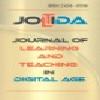Discipline or Classroom Management
Discipline or Classroom Management
discipline, classroom management, psychoanalytic method, behavior modification misbehavior,
___
- Anderson, L. M. & Prawat, R. S. (1983). Responsibility in the Classroom: A Synthesis of Research on Teaching Self-Control. Educational Leadership, 40(7), 62- 66.
- Bowman, R., Jr. (1983). Effective Classroom Management: A Primer for Practicing Professionals. Clearing House, 57(3), 116-118.
- Brophy, J. (1986). Classroom Management Techniques. Education and Urban Society, 18(2), 182-194.
- Brophy, J. E. (1983). Classroom Organization and Management. The Elementary School Journal, 83(4), 265-285.
- Chan, S. M. (1997). Classic and Contemporary Readings in the Philosophy of Education. The McGraw-Hill Companies, Inc.
- Cobb, H. C. & Richards, H. C. (1983). Efficacy of Counselling Services in Decreasing Behavior Problems of Elementary School Children. Elementary School Guidance & Counselling, 17(3), 180-187.
- Crouch, P. L., Gresham, F. M., & Wright, W. R. (1985). Interdependent and Independent Group Contingencies with Immediate and Delayed Reinforcement for Controlling Classroom Behavior. Journal of School Psychology, 23,177-187.
- Docking, J. (1982). The Impact of Control and Management Styles on Young Children in the Early Years of Schooling. Early Childhood Development and Care, 8, 239-252.
- Doyle, W. (1989). Classroom Management Techniques. In Strategies to Reduce Student Misbehavior, edited by Oliver C. Moles. Washington, DC: Office of Educational Research and Improvement, p.11-31.
- Dreikurs, R., Grunwald, R.B., & Pepper, F. C. (1971). Maintaining Sanity in the Classroom: Illustrated Teaching Techniques. New York: Harper and Row.
- Duke, D. L. (1989). School Organization, Leadership, and Student Behavior. In Strategies to Reduce Student Misbehavior, edited by Oliver C. Moles.
- Washington, DC: Office of Educational Research and Improvement, p.31-62.
- Gettinger, M. (1988). Methods of Proactive Classroom Management. School Psychology Review, 17(2), 227-242.
- Jones, F. H. (1979). The Gentle Art of Classroom Discipline. National Elementary Principal, 58, 26-322.
- Kounin, J. S. (1970). Discipline and Group Management in Classrooms. New York: Holt, Rinehart and Winston, Inc.
- Kilpatrick, W. H. (1925). Foundations of Method: Informal Talks on Teaching, New York: Macmillan.
- Lasley, T. J. & Wayson, W. W. (1982). Characteristics of Schools with Good Discipline. Educational Leadership, 40(3),28-31.
- Luke, M. D. (1989). Research on Class Management and Organization: Review with Implications for Current Practice. Quest 41, 55-67.
- Rich, S. G. (1925). Is discipline useful? Journal of Educational Method, 4, 296.
- Satchel, B. (1992). Increasing Prosocial Behavior of Elementary Students in Grades K-6 through a Conflict Resolution Management Program, ERIC Number: ED347607, http://eric.ed.gov/?id=ED347607
- Strother, D. B. (1985). Practical Applications of Research. Phi Delta Kappan, 66(10), 725-728.
- Sunshine, P. M. (1973). Approaches to School Discipline: A Selected Review of the Literature, No. 2. ERIC Number: ED087084, http://eric.ed.gov/?id=ED087084
- Yayın Aralığı: 2
- Başlangıç: 2016
- Yayıncı: Mehmet Akif Ocak
Discipline or Classroom Management
Serkan PERKMEN, Ahmet Haktan SİVRİKAYA
Determination of Cyber Security Awareness of Public Employees and Consciousness-rising Suggestions
Huseyin KURU, Mehmet Akif OCAK
Anna NEWLEY, Hasan DENİZ, Erdogan KAYA, Ezgi YESİLYURT
An Instructional Design Model for Blended Higher Education
Ozcan DEMİR, Ahmet ATAN, Yücel GELİSLİ
Comparative Effectiveness Research and Its Application to Nursing Education
